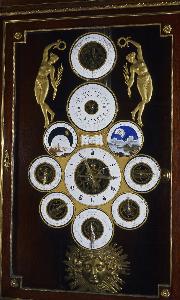Antide Janvier
Antide Janvier
Place: Lavans-Lès-Saint-Claude
Born: 1751
Death: 1835
Biography:
Antide Janvier was a renowned French clockmaker, born in Lavans-lès-Saint-Claude, France in 1751 and died in 1835. He was educated in Latin, Greek, mathematics, and astronomy by a local abbé. At the age of 15, he built an astronomical sphere which he presented to the Academy of Sciences of Besançon, which won him wide admiration, and he began his career as an apprentice watchmaker.
Career and Achievements
Janvier gained a reputation as a maker of ingenious and complicated clocks, including many astronomical clocks and clocks showing the tides. He was also famous for his double pendulum clocks, also called Resonance clocks, which he was the first to make. He eventually became Louis XVI's royal clockmaker. After the French Revolution, Janvier spent time in prison because of this royal association and then fell on hard times; his hardships were increased by the death of his wife in 1792. He sold his watches and equipment and designs to Abraham-Louis Breguet, who sold watches under his own name. Following the restoration of the monarchy under Charles X, Janvier was awarded a small pension beginning in 1826, but died in poverty and obscurity.
Legacy and Collections
Janvier's work can be found in various museums and collections, including the Musée D'art et D'histoire de Cholet, which houses an impressive collection of artworks that showcase the rich cultural heritage of the region. Some of his notable works include Painting by 'Antide Janvier': Astronomical Clock, and Painting by 'Antide Janvier': Double Pendulum Clock.
- Visit Wikioo.org to learn more about Antide Janvier
- Discover the Musée D'art et D'histoire de Cholet (France)
- Explore other artists and their works on Wikioo.org
Janvier's legacy as a clockmaker continues to be celebrated, and his work remains an important part of French cultural heritage. His contributions to the world of horology are still studied and admired by scholars and collectors today. Wikioo.org offers a wide selection of Janvier's works, including Painting by 'Antide Janvier': Astronomical Clock, and Painting by 'Antide Janvier': Double Pendulum Clock. Visit their website to learn more about this renowned clockmaker and his contributions to the world of art and horology.

